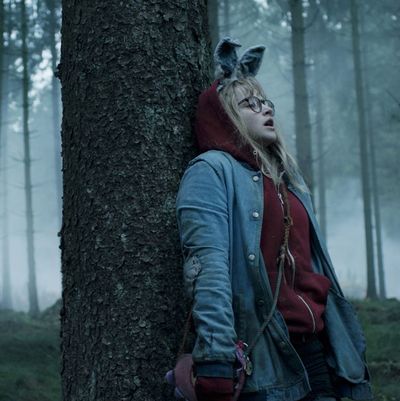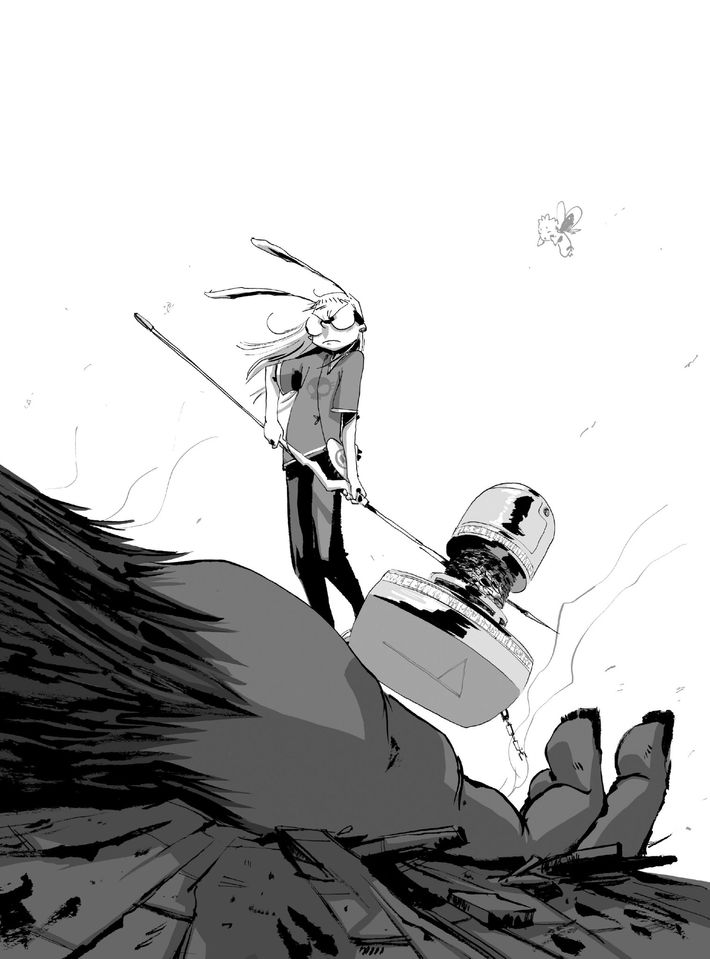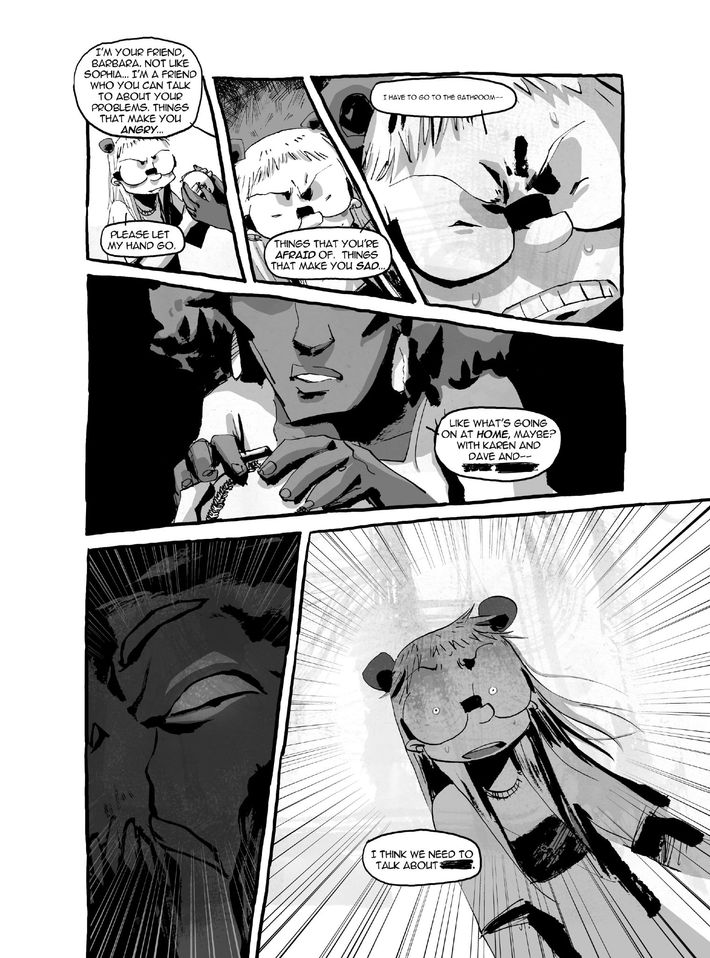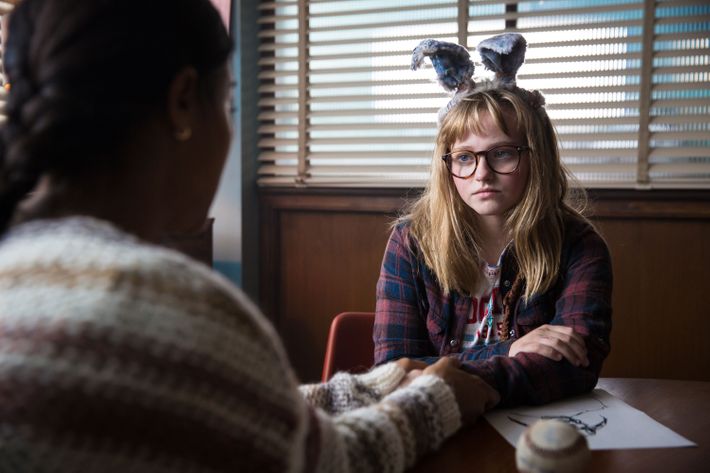
I’d been on the phone with I Kill Giants director Anders Walter for less than a minute before I felt compelled to tell him something embarrassing. I’d watched a streaming screener of the film at work a few days prior and it had punched me squarely in the gut. “You helped me reach a landmark,” I said, “which was I had the first time I ever cried in my office.”
“That’s the purpose of the film,” Walter replied. “To make big boys cry.”
Walter is serious. Roger Ebert famously said movies are like machines designed to generate empathy, and rarely has that been more true than in the case of I Kill Giants. The same goes for the graphic novel of the same name, from which it was adapted; the story is an attempt to take its progenitor’s anguish and hope about his family and translate them into something universally moving.
That progenitor is comics writer Joe Kelly, and the story he and artist J.M. Ken Niimura initially crafted a decade ago has become a modern classic of indie comics. To explain it too much is to spoil a significant portion of the surprises. Suffice it to say that the narrative — in both print and film form — follows a geeky and defiant Long Island tween named Barbara as she navigates internal emotional turmoil and external threats from massive creatures she’s sworn to defeat. Fact and fantasy blur as the reader/viewer attempts to suss out whether these giants and titans truly exist, but Barbara’s battle with a mystery-shrouded trauma is undeniably real.
The story came out of a period in the early aughts when Kelly was swimming in brackish water of joy and pain. On one hand, he was inspired by his own growing child. “My daughter was a precocious 6- or 7-year-old kid who I was trying to turn into a nerd,” Kelly recalls. “But at the same time, my father had a bout with diabetes and he wound up in the hospital for quite a long time, and wound up losing half of his leg after many, many surgeries. It was the first time I really ever thought about the mortality of my parents.” The combination of those experiences was potent: “Having kids and having a dad who was sick started the juices going creatively.”
Inspiration struck in an unlikely setting. “One day, I took my dad to rehab while he was learning how to walk on his new artificial leg,” Kelly says. “And I had a yellow pad, and I just wrote the whole thing down in basically an hour. The outline for the story really never changed. It was just eight, nine pages of a free-associated ‘Here’s the story.’ Very rarely do you get that kind of lightning-in-a-bottle moment.” Even the title emerged fully formed. “It was always I Kill Giants,” he says. “It just felt right and it felt like Barbara.”
At the time, Kelly had the luxury of being able to do more or less whatever he wanted. He’d made a name for himself writing for comics-publishing titans Marvel and DC around the turn of the millennium and had co-founded a multimedia writers’ collective called Man of Action. He was known as a purveyor of stories with heart and hope, especially a career-making 2001 Superman story called “What’s So Funny About Truth, Justice & the American Way?” in which Supes defeated a cynical, murderous superteam in a meta-textual attempt to demonstrate that idealism still has a place in comic-book storytelling.

But it was a deeper cut that brought the scribe to Niimura’s attention. Kelly had, alongside artist Chris Bachalo, helmed a cult-hit comic called Steampunk, which crafted a vision of a technologically advanced Victorian England. “I was a huge fan,” says Niimura. Raised in Spain by a Japanese father and fluent in four languages, Niimura had a wildly different background than Kelly’s. Nevertheless, fate or chance brought the unlikely pair together when they were slotted next to one another at a Spanish comic-con’s autograph tables in the mid-aughts.
Niimura hadn’t found fame yet, but Kelly was transfixed by the explosive, manga-influenced style on display in the comics the artist was selling. “So, as all writers do, I tried to get my hooks in him right away and scoop him up before anybody else discovered him,” Kelly recalls with a laugh. He asked Niimura if he’d be interested in collaborating and got an enthusiastic yes. Niimura says he has only one regret about that first encounter with his hero: “I went back home and I was like, Oh, shit, I could’ve asked for an autograph!”
Kelly pitched I Kill Giants to Niimura over email and, after about a year of waiting while Niimura finished art school in Madrid, the two got to work. The script being more or less finished by then, their primary task was design, which proved to be arduous. “I spent more than half a year working on the designs and the backgrounds,” Niimura recalls. “At the beginning, they were in my style, but a little bit more realistic. But they lacked …” He trails off for a moment. “I don’t know, the character designs, they didn’t work. They weren’t iconic enough.” So, for Niimura, it became a go-big-or-go-home endeavor. “I re-did them and made them a little bit more character-like — more cartoony in a way.”
That philosophy proved to be crucial in the visual realization of Barbara’s head. Her glasses and expressions got bigger. Initially, Niimura based her hair on the curls of Kelly’s daughter — trouble was, the book was going to be in black and white, and Niimura felt that the hair “looks like spaghetti” in that medium. Frustrated, he still wanted something striking going on up there. In Kelly’s recollection, Niimura said, “‘You know, I was thinking about the kids that I know who are into manga, and anime, and Dungeons & Dragons, and all that sort of stuff, and, sometimes they wear stuff like this,’ and there were a bunch of drawings of Barbara with cat ears and weird sort of Sherpa hats — and the bunny ears.” Kelly was smitten with the latter, and thus was born Barbara’s iconic headgear, beloved by cosplayers, which very much survives into the film.
So, too, does Barbara’s mystical, enormous, giant-fighting hammer, Coveleski. It’s an odd name for a weapon, one with roots in baseball and Google. “It was a gift of the internet,” Kelly says. “I wanted her to name the hammer, and I had all my sort of dopey D&D names that I was batting around and I was like, there’s got to be something cooler.” He turned to his computer for guidance. “I literally typed in ‘giant killer’ just to see what would come up, and up comes this baseball story, about Harry Coveleski” — an early-20th-century pitcher whose skill at taking down the top-ranked New York Giants earned him the nickname “the Giant Killer.”
In translating Coveleski (the hammer, not the dude) into a visual, Niimura looked to one of his favorite pastimes: role-playing games. He says he initially sketched out a relatively normal-looking hammer, but Kelly urged him to think bigger and “make it something cool,” in Niimura’s recollection. So Niimura took inspiration from fantasy game Warhammer and made the weapon twice Barbara’s size and covered in accoutrements. “You see it and you totally know that that wouldn’t possibly exist in real life,” Niimura says. “It’s very much something that would have come out of the mind of somebody who’s into role-playing games, as Barbara is. The juxtaposition of the real environment versus this design that actually doesn’t work, works for me.”
But what would a story called I Kill Giants be without, well, giants? In thinking about their relative size to Barbara, Niimura turned again to gaming inspiration, this time the video game Shadow of the Colossus, which features skyscraper-sized baddies. Niimura wanted to strike terror into the reader, so he primarily represented the creatures in suggestive silhouette, with “fragments of a mouth, or teeth, or eyes, and something that you wouldn’t be able to know what it is.”

He also kept giving them a slightly more scandalous attribute: enormous swinging penises. “I said finally, ‘Ken, why are they all naked?’” Kelly says. “And he said, ‘Well, it was one of the scariest things I could think of that would be running at me: this 30-foot penis swinging there.’” Kelly laughs. “I said, ‘Yeah I know, in the European comics that might be okay, but we’re gonna have to tone that down for American books.’”
The genital-free monsters and the girl who opposes them were instant hits once Man of Action and indie publisher Image Comics printed I Kill Giants in serialized form in 2008 and 2009. “I Kill Giants is one of those titles that, try as I might, I probably can’t quite capture in words. But it’s something that every one of you should be reading,” said critic Richard George. “I consider this book to be the modern successor to Calvin and Hobbes, and I’m hard-pressed to think of a better compliment for any book,” wrote comics reviewer Jesse Schedeen. It won laurels from the Young Adult Library Services Association and the Ministry of Foreign Affairs of Japan. Vulture’s own Dan Kois listed it as one of the best comics of the year.
Fans clamoring for a movie adaptation couldn’t have known how far along that process actually was. As it turns out, Kelly had written a screenplay for I Kill Giants almost immediately after completing the comic’s script. “After I finished it as a comic and I didn’t have somebody to draw it at the time, I really was just still kind of obsessed with it, so I wanted to see how it would play out as a film,” he recalls. Editing the screenplay affected the way he thought about the comic and vice versa. “It was a very organic, kinda circular process. I’ve never done it since. I wouldn’t normally simultaneously do that.”
Years later, after publication of the comic, a circuitous route of friends and contacts moved the screenplay into the hands of producer-director Chris Columbus, who fell in love with it. Kelly recalls making a bold statement to Columbus in their initial meetings. “I had to say to him, ‘I just want you to know that I’m the only person who’s ever going to write this movie and if that’s a problem, then we can stop here and part ways,’” Kelly says with a little chuckle. Columbus was game for that, and the film went into development.
Enter Anders Walter, for whom I Kill Giants has been a rocky road. The Danish auteur had burst onto the scene with 2014’s Helium, a tale about a hospitalized boy that won the Academy Award for best live-action short film. However, after that success, he’d fled from Hollywood back to Copenhagen. “I had heard so many crazy stories from my Danish colleagues that Hollywood would just suck you up like you’re a nobody,” he recalls. “But then the script I Kill Giants came around, and my agent sent the script to me and I just fell deeply, madly in love with the screenplay.”
The process that ensued was, for a time, not a happy one. Hurdles abounded and the production fell apart at one point. Walter had seen Zoe Saldana in the 2013 Christian Bale–led thriller Out of the Furnace and became convinced she had to play Mrs. Mollé, Barbara’s guidance counselor. (The character is loosely based on Kelly’s wife, who is also a guidance counselor and whose Italian maiden name is Mollé.) Saldana waffled on the proposal for months, then finally took a meeting with Walter. “We really didn’t talk that much about the film,” he recalls. “All of a sudden, she said, ‘I have to go — my kids need me up at the house.’ And I was like, ‘Hey, wait! We have to talk about I Kill Giants!’ And then she just looked at me and said, ‘Hey, relax. I’m going to do it.’”
But that wasn’t enough to get the production to the finish line. A financier came onboard in 2015, then backed out because, in Walter’s retelling, they couldn’t get the budget small enough and couldn’t presell the independent film to a distributor. Another financier came onboard, but this one was European and, according to Walter, wanted to shoot in Ireland — a schlep that Saldana was unsure about making. Finally, she agreed and filming began there, with Saldana appearing opposite The Conjuring 2’s Madison Wolfe as Barbara and Roadies’ Imogen Poots as Barbara’s put-upon older sister, Karen.

The finished product is — unsurprisingly, given Kelly’s involvement — a more or less direct porting of the comic. However, a few changes were necessary. One comes during the climax and its immediate aftermath, about which we will say nothing for fear of spoilers. Another is the lack of the magical pixies that Barbara interacts with and mystical armor she wears in the graphic novel. Kelly was reluctant to lose them, but came under pressure to do so.
“Everybody was like, ‘Well, if we’re gonna have pixies floating around and armor appears on her body that people then don’t notice or comment on, then you know it’s a fantasy and you can’t run that game of ‘Is it real or is it not,’” he says. And the early days of talking to higher-ups demonstrate that it could’ve been worse. “We did meet people very early on who were like, ‘Could she fight, like, 120 giants? Could that be part of the story?’” He laughs. “And it’s like, ‘No, no, that’s not what this is about.’”
What it is about is childlike bravery and the struggle to find peace at an age when you lack the emotional wherewithal to sort out your problems on your own. Unsurprisingly, those motifs have resonated with comics fans on a soul-deep level. Both Kelly and Niimura can tell you of countless times they’ve interacted with readers who were moved by their work. (Oh, and for all those superfans out there: The men say they’re working on a new project together, though mum’s the word on what it is.) Cosplay with enormous Coveleskis and well-worn bunny ears is not uncommon at conventions.
“Somebody just hit us up on Twitter yesterday or today with a tattoo,” Kelly says, his voice rising with excitement, even though it’s far from the first I Kill Giants tattoo he’s seen. “People really dig deep and the book strikes them in a really meaningful way.” The film likely won’t shatter box-office records, but Kelly says that’s not the point, as far as he’s concerned. “You obviously want all sorts of success,” he says, “but if you can connect to a person who needs the movie — if they find themselves in Barbara, if they get her journey and it strikes them on a gut level — then I’m a super-happy camper.”

